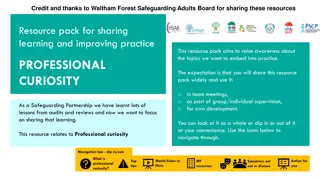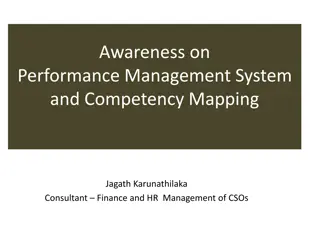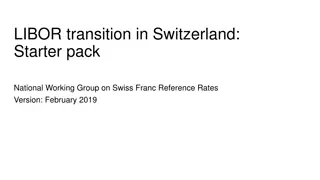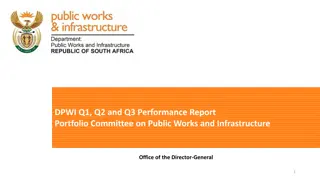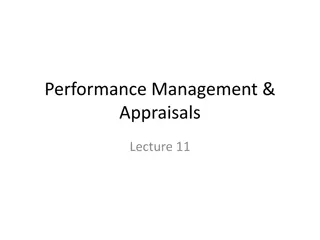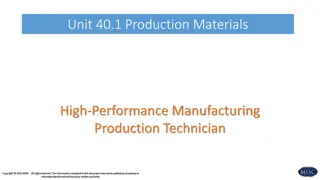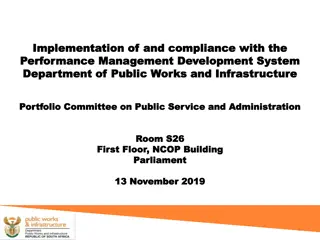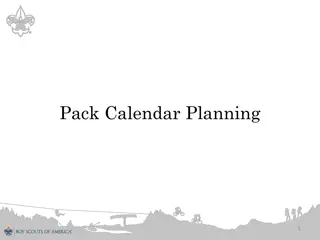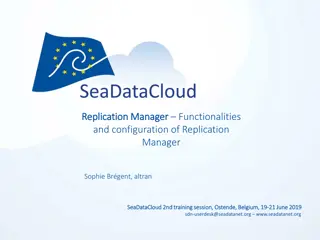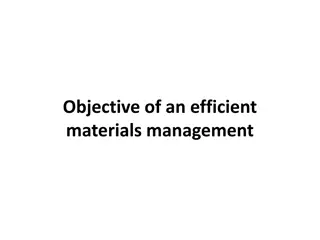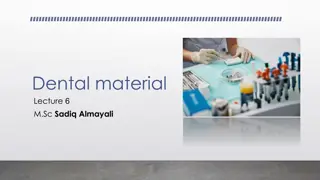Performance Management Pack - Manager's Materials Overview
This pack includes materials for running performance management sessions, focusing on clarifying strengths, reviewing goals, and setting future targets. It provides a framework for effective dialogue and goal achievement.
Download Presentation

Please find below an Image/Link to download the presentation.
The content on the website is provided AS IS for your information and personal use only. It may not be sold, licensed, or shared on other websites without obtaining consent from the author.If you encounter any issues during the download, it is possible that the publisher has removed the file from their server.
You are allowed to download the files provided on this website for personal or commercial use, subject to the condition that they are used lawfully. All files are the property of their respective owners.
The content on the website is provided AS IS for your information and personal use only. It may not be sold, licensed, or shared on other websites without obtaining consent from the author.
E N D
Presentation Transcript
The Performance Management Pack The Manager s Materials
Introduction This pack provides a framework you can use to run a performance management session. The aims of the sessions are: To clarify the person s strengths - the activities in which they deliver As, as well as where they deliver Bs and Cs - and their agreed contribution to the organisation. To review their present performance and to what extent they have achieved their previously agreed goals. To make clear contracts about their future goals and the support they need to achieve these agreed goals. Taking these steps will provide the opportunity for real dialogue and a reality check. It will also enable the person to make their best contribution to the organisation. This pack is made up of the following sections.
The Performance Management Pack - The Team Member s Materials These are the materials that will be sent out to the person to fill-in and return before the session. The Performance Management Session The Manager s Road Map This provides a road map you can follow before, during and after the session. The Performance Improvement Pack This provides a framework you can use in the case of there being difficulties with a person s performance. Finally, it is important to use these materials as a framework, Please take the ideas and use them to continue to help people to make their best contribution to the business.
The Performance Management Pack The Team Member s Materials This part of the pack is to be sent to the team member two weeks before the planned meeting. Ask them to send it back to you at least two days before the session.
Introduction This pack invites you to do several things to prepare for the performance management session. Some of these exercises you may only need to do occasionally, such as clarifying your strengths. Others you may do on an ongoing basis. The pack invites you to do the following things. To clarify your strengths and your best contribution. To clarify your agreed goals. To clarify how you will keep your manager informed about your progress towards achieving the agreed goals. To then review your present performance and the extent to which you have achieved your previously agreed goals. To make clear contracts about your future goals. Here are the exercises.
My Strengths
Introduction Peak performers do what they do best and do it brilliantly. They also find ways to manage the consequences of their weaknesses. This exercise invites you to do the following things. Describe the deeply satisfying activities in which you deliver As. These may be particular kinds of projects, tasks or other activities. Try to be as specific as possible and give concrete examples. Describe the activities in which you deliver Bs and Cs. The B activities are probably those that you can do reasonably well. They are not your As, however, or maybe they were once but now you get bored doing them. The C activities are those in which you have little aptitude or desire to learn (Please note: If you have previously done this exercise - and both you and your manager are fully aware of your strengths - you may simply move onto the second exercise.)
My Strengths The specific activities in which I deliver As, rather than Bs or Cs, together with some examples are: 1) For example: * * *
2) For example: * * *
3) For example: * * *
Bs. The specific activities in which I deliver Bs are: 1) For example: * 2) For example: *
Cs. The specific activities in which I deliver Cs are: 1) For example: * 2) For example: *
My Best Contribution Towards Achieving The Picture Of Success
Introduction Bearing in mind the team s picture of success and your strengths, this exercise invites you to describe the following things. The specific results you aim to deliver towards achieving the team s picture of success. These aims should be written in outcome terms - such as the specific results you will deliver - rather than as a list of activities. The specific benefits - to the various stakeholders - of delivering these results. The specific things you will do to proactively update people about your progress towards achieving the results.
The specific support you would like to help you to achieve the results. The specific early successes you will aim to deliver. Complete these exercises up to and including the page Specific Early Successes and send these to your manager. You can then agree on your goals for the year. After the meeting you can then complete the section in which you write your agreed goals for the year.
Some Background We aim to build a strengths based team and co-ordinate these strengths to reach the goal. We must, however, deliver the Scorecard. These are the mandatory things the team must deliver. This will sometimes mean everybody getting involved in doing great work and helping to do the other tasks. We want to encourage you to build on your strengths, because you are then more likely to do great work. At the same time, however, it is your responsibility to manage the consequences of any weaknesses. We want to manage by outcomes, rather than by tasks. Once the outcomes are agreed, we ask you to be accountable for delivering the goods. How you achieve this - providing your follow the organisation s agreed principles - is up to you and your team. Here are the exercises.
My Specific Contribution Bearing in mind the picture of success and my strengths, the specific results I want to deliver towards achieving the team s goals are: 1) To For example: - To - To - To
2) To For example: - To - To - To
3) To For example: - To - To - To
The Specific Benefits The specific benefits of making this contribution - for the team, customers, colleagues and other stakeholders - will be: 1) To For example: 2) To For example: 3) To For example:
The Specific Updates The specific things I will do to proactively keep people informed about the progress towards delivering the results will be: 1) To For example: 2) To For example: 3) To For example:
The Specific Support The specific support I would like to help me to achieve the goals, plus the support I will give to other people, is: 1) To For example: 2) To For example: 3) To For example:
The Specific Early Successes The specific early successes I will aim to deliver will be: 1) To For example: 2) To For example: 3) To For example:
My Agreed Goals
Introduction After clarifying your strengths you will then meet with your manager and agree on your goals. When doing this, it is important to bear in mind the team s picture of success and your strengths. You will then agree with your manager on your contribution towards achieving this picture of success. Try to write your goals in outcome terms. Describe the actual things you will deliver, rather than a set of activities. You can then keep referring back to these goals when having ongoing meetings with your manager.
After meeting with my manager, the agreed specific results that I will aim to deliver are: 1) To For example: - To - To - To
2) To For example: - To - To - To
3) To For example: - To - To - To
My Progress Reports
Introduction This section provides a framework you can use for meeting regularly with your manager. Bearing in mind the results you aim to deliver, it invites you to do the following things. Describe the specific outcomes you have agreed to deliver. Describe the specific things you have delivered in the past month (or other time frame). Describe the specific things you aim to deliver in the next month (or other time frame). Describe any other things you would like to discuss in the meeting with your manager.
The Specific Goals The specific outcomes - the results - I aim to deliver by are: 1) To For example: 2) To For example: 3) To For example:
The Past Month The specific things that I have delivered in the past month towards achieving these goals have been: 1) To For example: 2) To For example: 3) To For example:
The Next Month The specific things that I aim to deliver in the month towards achieving these goals are: 1) To For example: 2) To For example: 3) To For example:
The Summary The other things I would like to discuss - such as any challenges I face, my plans for tackling these, any support I need and any other topics I would like to explore - are : 1) To 2) To 3) To
My Performance Review
Introduction This section provides a framework you can use to assess your own performance. It invites you to do the following things. Describe each of the specific agreed goals you aimed to achieve. Describe the rating you would give yourself in terms of achieving each of these specific goals. Do this on a scale 0-10. Describe the specific things you believe you are doing well - or have done well - and how you can build on these things. Describe the specific things you believe you can do better and how. You can send this part of the review to your manager before meeting with them. This will provide some material that you can discuss during the meeting. After the meeting you can then do an exercise where you describe your future agreed goals. We will give more explanation about this later in the materials.
My Agreed Goals Were The Following 1) To For example: - To - To - To The rating I would give myself in terms of achieving this goal - on a scale 0-10 - would be: ____ / 10
2) To For example: - To - To - To The rating I would give myself in terms of achieving this goal - on a scale 0-10 - would be: ____ / 10
3) To For example: - To - To - To The rating I would give myself in terms of achieving this goal - on a scale 0-10 - would be: ____ / 10
What I Am Doing Well. The specific things I am doing well - or have done well - are: 1) For example: - 2) For example: - 3) For example: -
The specific things I can do to build on what I am doing well are: 1) For example: - 2) For example: - 3) For example: -
What I Can Do Better. The specific things I can do better and how are: 1) For example: - 2) For example: - 3) For example: -
My Future Goals
Introduction This section provides a framework you can use complete after the performance review. It follows the same format as before for describing your agreed goals. You can then keep referring back to these outcomes when having discussions with your manager. As mentioned earlier, it is important to proactively keep people informed about your progress. You can use the framework shown earlier for meeting with your manager on a monthly basis. This framework is included again to provide a template for these meetings.
My Agreed Future Goals
After meeting with my manager, the agreed specific results that I will aim to deliver are: 1) To For example: - To - To - To
2) To For example: - To - To - To
3) To For example: - To - To - To
My Progress Report
The Specific Goals The specific outcomes - the results - I aim to deliver by are: 1) To For example: 2) To For example: 3) To For example:




